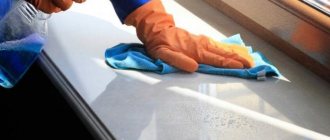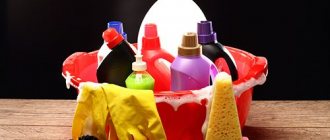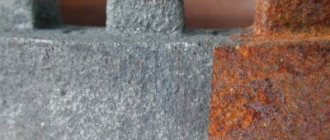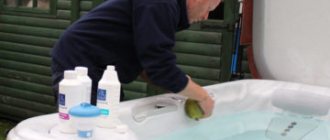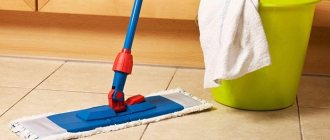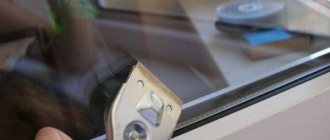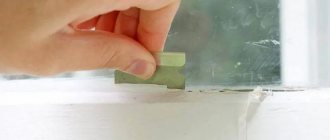White color is associated with purity and sterility. The smallest particles of dirt, rusty streaks and puddle spots are visible on the white. If they are not there, taking a bath is a pleasure. Now about the unpleasant stuff. It is more difficult to remove rust from a bathroom than from a toilet. When treating with bleach you have to breathe in caustic fumes.
Aggressive means spoil enamel and acrylic, and traditional methods often do not work. Fortunately, not everything is so hopeless. You can get rid of rust in the bathtub in 3-5 minutes. We will tell you in detail how to do this safely and correctly.
Causes of rust on the bathtub
It’s hard to imagine plumbing fixtures without rust (but I would like to). It appears wherever there is moisture, metal and oxygen.
Rust forms when iron reacts with oxygen in the presence of water or moisture in the air.
Many people mistakenly believe that if the bathtub is acrylic and the faucet is plastic, yellow stains will not appear. We have to disappoint. Tap water contains iron oxides. Sooner or later they lead to the appearance of a red coating on the white walls. The higher the content of the element, the faster the bath takes on an unkempt appearance.
The appearance of rust is also promoted by:
- old cast iron and steel pipes in the apartment and house;
- rusty tap;
- accumulation of water in the bath (in hollows, grooves, enamel pores);
- high humidity in the room;
- draining water (faulty tap);
- foreign objects: hoses, basins, silicone mats, etc.;
- improper care of the bathroom.
The last factor is decisive. Some housewives go too far in their quest to remove rust from the bathroom. They use aggressive chemicals that, along with plaque, destroy the coating. The surface of the bathtub becomes rough, and rust forms much faster.
Proper care of your bathroom is the key to its cleanliness and long service life.
Prevention of occurrence
It is possible to prevent the appearance of red streaks and limescale on the walls of the bathtub, provided that certain rules of prevention are followed:
- It is necessary to rinse the walls of the bath after each use.
- A timely repaired faucet or shower guarantees the absence of rusty stains on the walls of the bathroom.
- Filters installed on the water supply system of the house will make the water cleaner and keep the surface of the bathtub from limescale and rusty deposits.
Regular cleaning and disinfection will help maintain the original whiteness of the bathtub walls for a long time.
Features of cleaning surfaces made of different materials
Methods and products that are ideal for enameled cast iron can destroy acrylic. And vice versa.
You should always take into account the characteristics of the material you are going to clean.
- Acrylic. Polymer material (polymethyl methacrylate). Special products are produced for the care of acrylic bathtubs. Acrylic is quite gentle and does not tolerate the use of concentrated alkalis, acids, ammonia, chlorine, and acetone. They leave stains and dull the surface. Also, do not clean the material with metal sponges or hard abrasives. Acrylic is scratched.
- Enamel. Glassy mass, resistant to chemical attack. Theoretically, enamel baths can be cleaned with bleach, acids and alkalis. But in practice, enamel is often damaged by caustic substances - it becomes rough and porous. Enamel is more difficult to scratch than acrylic. It can be cleaned with brushes and soft abrasives.
It is recommended to do some testing before using a new rust remover. Apply the mixture to an inconspicuous place (for example, the edge of a side wall), leave for 15 minutes and rub.
If there are scratches on the surface and the gloss will come off, the bath cleaner is not suitable. Leave it for cleaning the toilet, and choose a different composition for the bathroom.
Recommendations for acrylic bathtubs
Acrylic bathtubs have a perfectly smooth, but prone to damage surface. If handled carelessly, it is easily scratched, and strong concentrated substances can corrode the product. The coating of an acrylic bathtub has no pores, so dirt does not penetrate into it, and cleaning agents are completely washed off with water. But the material is easily painted and can change color: due to rust, acrylic first appears yellow, and then a brown deposit.
Acrylic is not susceptible to corrosion, but it is difficult to wash off old plaque. Entrenched rust can only be removed with aggressive agents that are contraindicated for acrylic surfaces.
The following recommendations will help maintain the integrity of the acrylic coating when cleaning:
- To prevent the detergent from corroding the bathtub, use only special products for acrylic surfaces (there should be information about this on the packaging). For acrylic baths, there are special compositions based on fruit acids.
- Acrylic cannot be cleaned with metal brushes, scrapers or too hard sponges.
- The exposure time of cleaning agents must not be exceeded. Even gentle acidic compounds are best applied for no more than 30 seconds. If it is not possible to remove the plaque immediately, it is better to repeat the treatment after some time rather than overexpose the product and ruin the surface.
- Just in case, it is advisable to test all products on an inconspicuous area.
If you do damage it, here are instructions on how to restore the surface of the bathtub.
Cleaning rust: traditional methods
It must be admitted that household chemicals are a relatively recent invention of mankind. Previously, improvised means were used to combat rust. It worked out cheaper. But the effect was not much different. “Ancient” household products coped with their task noticeably worse than modern ones.
In the last 10 years the situation has changed dramatically. Today, using household chemicals is more profitable than using traditional methods, and it copes with rust much better.
Home remedies are good only in cases where nothing else is at hand, or there are small children and allergy sufferers in the house.
We advise you not to wait for the “wow” effect. He won't be there. Traditional methods can only cope with fresh plaque. If you are a fan of environmentally friendly methods and the rust is old, it is better to take a closer look at a cleaning stone or use a steam generator (more details below).
Baking soda and citric acid
Baking soda and citric acid are often used to clean the house. They are in every home and cost pennies. The alkali contained in soda softens plaque. And citric acid reacts with it. Carbon dioxide is released. The rust separates from the walls and can be easily washed off.
How to clean a bathtub from rust using baking soda and lemon:
- Pour 100 g of soda (half a pack) into a convenient container.
- Pour 50 ml of water, stir lightly.
- Take a sponge and rub the walls and bottom of the bath well.
- Wait 10-15 minutes.
- Dissolve 30 g of citric acid (2 heaped tablespoons) in a glass of warm water.
- Soak a sponge in an acidic solution and apply it over the soda. A violent reaction will begin. The solution will fizz and bubble. You need to rub the rust well.
- At the end, all that remains is to rinse the bath with clean water. The lemon and soda will disappear without a trace, and the walls will shine with cleanliness.
We recommend: Mattress topper – what is it and why buy it?
Even though the ingredients are harmless, cleaning must be done with rubber gloves!
Baking soda and lemon dry the skin and can cause irritation (redness, tingling).
Cleaning gel made from laundry soap
It takes quite a long time to prepare, but the result is worth it. The home remedy has a gel-like consistency. The gel spreads well over the walls of the bath. It can be used to clean acrylic, enamel, and metal. To remove rust you need:
- Grate 1 bar of laundry soap on a coarse grater.
- Add a glass of water.
- Place the container in a water bath.
- Squeeze the juice of 2 lemons and pour into the heated mixture. Lemon juice can be replaced with 2 tbsp. spoons of citric acid.
- Mix well. Remove from steam bath.
- Add 3 tbsp. spoons of glycerin.
- Add 1 tbsp. spoon of vodka, stir.
- Distribute the gel over the surface of the bathtub.
- After 15-30 minutes, lather well and rinse with hot water.
The product can be stored in a closed jar for up to a month.
Vinegar and hydrogen peroxide
To whiten yellowed plaque, prepare the following solution:
- 100 ml table vinegar (6-9%);
- 30 ml hydrogen peroxide.
The solution is distributed throughout the bath and then wait 15 minutes. Rub the surface with a brush and wash everything off. You can additionally sprinkle the walls with soda or washing powder. This way the rust will come off faster.
Attention! When using vinegar, you need to open the doors, turn on the hood, and wear gloves.
Toothpaste
The following method is often used by owners of acrylic bathtubs. Toothpaste gently cleanses the surface. It copes well with fresh yellow plaque and dried dirt. It is enough to apply the paste for 3-5 minutes and rub everything with a brush. Usually it is used to clean drains and small drips. Cleaning the entire bathtub with toothpaste turns out to be expensive.
Soda and liquid soap
Baking soda in combination with liquid soap removes yellow discoloration better. Thanks to its creamy consistency, the home remedy spreads easily over the walls of the bathtub.
You need to pour 4 tbsp into a bowl. spoons of baking soda, add 2 tbsp. spoons of liquid soap or shampoo.
The pulp is mixed and rubbed onto contaminated areas. After 15 minutes, lather with a brush and rinse off.
Sorrel
The old way. Previously, sorrel was used to clean bathtubs from rust in villages. You need to cover the bottom of the tub with fresh leaves, add a little water and rub the mass with a stiff brush to release the juice. Add water to the top. In the morning, remove the sorrel and wash the bath with soap and a brush. She will become snow-white!
How to use household chemicals
If you can’t get rid of dirt with home remedies, use cleaning powders and gels.
- Read the composition and consider the type of bath.
- It is better to use environmentally friendly substances, but they are more expensive.
- Follow the manufacturer's instructions. For example, sometimes the solution needs to be washed off immediately, sometimes it needs to be left for a while to make the bath clean.
- Some products have a strong, unpleasant odor. This means that to use them, your bathroom must have good ventilation.
- Never clean a bathtub without gloves.
The easiest way to remove rust in the bathroom
To clean rust, you don’t have to use household chemicals or even home remedies! You can remove it with plain water and... a steam generator!
Modern housewives use a steam generator to remove rust, limescale, and mold. The narrow nozzle is convenient for processing seams and crevices. See for yourself how well steam removes yellow plaque:
Steam can be used to clean both acrylic and cast iron (enamel) bathtubs. The only disadvantage of this method is the high cost of technology. The average cost of a steam cleaner is 10,000 rubles.
What not to do and why?
In pursuit of perfect cleanliness, many ignore the prohibitions that can cause final damage to the surface of the plumbing:
Acrylic bathtubs can only be wiped with soft sponges, cloth or rags. Hard brushes and scrapers can not only scratch, but tear off the coating. For the same reason, you should avoid using dry cleaning powders.- The exposure time of household chemicals on the surface of the bathtub must not be exceeded. The result may be far from the expected effect.
- Do not use toilet bowl cleaners in the bathtub (the aggressive acid composition is harmful to the bathtub surface).
Before applying a new product, it would be a good idea to test it on a small area of the plumbing.
You will find a lot of useful information about rust removal in this section of the site.
Choosing a product in the store
The range of bath cleaning products is not just large, but huge. Conventionally, they can be divided into 2 groups:
- Based on chlorine (sodium hypochlorite). Such products are suitable exclusively for enamel baths. They whiten well, but can damage the surface. They have a pungent, suffocating odor. Apply only with gloves.
- Based on acids, surfactants (surfactants). The products cope well with all types of contaminants. Caustic, but does not emit fumes like bleach. In moderate concentrations, they do not damage acrylic and enamel.
The shape of the bathroom is not very convenient for washing. Therefore, the convenience of applying cleaning compounds is of great importance. In the store you can find:
- Liquid anti-rust products. The most affordable and the most inconvenient to apply. The liquid quickly flows from the walls of the bathroom and rushes into the drain. You need to cover it with something and spread the product well over the entire surface.
- Gel-like. Gels adhere better to the walls of the bath than liquid rust removers. True, they cost a little more. But they are spent more economically.
- In sprays. The most convenient option to apply. The product can be quickly and evenly distributed over the entire surface of the bath. However, comfort does not guarantee quality. The composition must be effective.
- Dry powders. Many people underestimate them. But in vain. Powdered cleaners sometimes work where other products fail. They not only whiten the bathtub, but also remove rust mechanically.
"Sarma Anti-rust 7 in 1"
A very popular bathroom cleaner. Does not contain chlorine. The smell is tolerable. Inside the bottle there is a bluish liquid that neutralizes the red tint in 5 minutes. You can’t leave the product on for longer, otherwise your bathroom will turn from snow-white to blue. Approximate price – 125 rubles. per 750 ml bottle.
"Sanox for plumbing" (green, 1.1 l)
It is considered one of the most effective remedies against rust in the bathroom. Contains citric, oxalic acid and surfactants. Effective immediately. Rust, limescale, and water stone dissolve before our eyes, even if they are very old. The smell is acceptable. The downside is that the product can corrode the enamel over time. You need to use Sanox rarely and keep it on the surface for no longer than 5-10 minutes. The average cost is 95 rubles.
"Pemolux soda 5 EXTRA"
Many people write in reviews that this is the best rust remover for the bathroom - cheap, effective, easy to use. Suitable for cleaning absolutely any surface, as it does not contain aggressive chemicals. The active ingredients are active oxygen, soft abrasive and soda.
We recommend: How to properly clean and cut up catfish
The average price for Pemolux soda 5 EXTRA is 70 rubles. There are 480 g of powder in a jar. It is enough for about 5 bath cleanings. To get rid of rust, you need to moisten the bath with water, sprinkle with powder and rub with a brush. Leave for 15 minutes. Brush again and rinse off any remaining cleaning product with hot water.
"Bagi Akrilan"
Detergent for acrylic bathtubs in spray form. Acrylan is easy to apply. The rust in the bathtub brightens before our eyes. Despite the relative high cost (400 rubles for a 400 ml bottle), many housewives praise it very much. When using Acrylan, acrylic bathtubs retain their original appearance for many years. But you need to keep in mind that the product has a pungent odor. Cleaning the bathtub should be done with gloves on while the hood is running.
"Cinderella for acrylic bathtubs"
Budget detergent, costing 60 rubles. per bottle 250 ml. Consists of surfactants and acids. Cleans acrylic from rusty deposits without damaging it. Can also be used for enamel bathtubs and cleaning any sanitary ware. "Cinderella for acrylic baths" is a transparent gel. Dissolves various types of contaminants in 10 minutes. The smell of the gel is not strong, but quite specific.
Universal stone
Innovative product. The universal stone is completely environmentally friendly. You can wash everything with it: dishes, bathtub, toilet, floor, windows, shoes and even a car. It contains only soap flakes, glycerin, clay, vegetable oils and green soap. The stone smells like clay and is used very economically - it replaces 50 liters of detergent. Suitable for cleaning any surfaces: enamel, metal, glass, ceramics, acrylic, plastic.
At first, the universal stone looks like a dense paste, and later hardens. Rub it with a damp sponge until a thick foam forms. This foam easily removes grease, carbon deposits, limestone, rust and any other contaminants. The cost of a small jar of 140 g is 360 rubles.
It is recommended to use the universal stone without gloves. The components of the detergent nourish the skin of the hands and strengthen the nails.
Using Coca-Cola at home
Everyone has heard that such a delicious drink as Coca-Cola can not only be drunk, but also used to revive the appearance of your plumbing fixtures. This is all due to the phosphoric acid content in soda.
There are several options for how to wash off rust in the bathroom with its help - for example, pour a drink over the contaminated areas, but this may not be entirely rational. Therefore, there is another way - soak a towel or several in Coca-Cola and apply it to the rusty marks and drips, and then leave it for several hours, periodically wetting the material again. You can also clean the faucet using this method.
This cleansing has a lot of advantages, because the drink is absolutely safe, it does not corrode the skin or harm the mucous membranes, it will not corrode some “sensitive” types of enamel, and a special “bonus” is the pleasant smell.
How to remove rust - step-by-step instructions
The rusty coating eats into the surface. The longer it stays on the walls, the harder it becomes. If you don't know how to remove it, use the step-by-step instructions.
How to clean rust in a bathroom:
- It is recommended to wet the bath before applying any product. The composition will be better distributed over the surface, and aggressive substances are less likely to damage the coating.
- Wear rubber gloves.
- Fresh plaque can be removed with baking soda and a kitchen sponge (hard side). This cleaning is recommended before bathing infants and allergy sufferers. Scrub the rust and then rinse the tub with hot water.
- If the rust is old, it is better not to waste time and energy on traditional methods. Use a store-bought product based on acids and surfactants. Spread it over the entire surface and leave for 5-10 minutes.
- Scrub the rust with a brush or sponge.
- Rinse the bathtub with clean water.
- If rust remains, repeat the treatment.
Here's how to get rid of rust in an enamel bathtub:
- Pour 250 ml of “Belizna” and 250 ml of water into a 0.5 liter bottle.
- Close the lid with a spray bottle.
- Mix in a circular motion.
- Spray the bath well.
- Leave overnight.
- Rub the contaminated areas with a brush or sponge with laundry soap.
- Rinse the bathtub with warm water.
What not to do and why?
Seeing severe rust in the bathroom, housewives often “overdo it.” The result is that the surface becomes rough and the gloss peels off. Dark spots may appear on acrylic and the enamel may chip. We advise you not to repeat the following mistakes:
- Use bleach, acetone, or ammonia to clean the acrylic bathtub.
- Mix cleaning products for greater effectiveness.
- Increase the exposure time to the composition specified in the instructions.
- Rub the rust with a metal sponge.
- Use chemicals not intended for cleaning bathtubs.
Special preparations
In the presence of severe manifestations of corrosion, special-purpose household chemicals will be effective. Their range is quite extensive for any type of bath covering. The packaging contains information about the composition, functions and conditions of use of the drug.
For acrylic surfaces, it is better to choose liquid and gel products . The thicker the consistency, the more economical its consumption.
Heavy stains on metal bathtubs can be gently rubbed with finely dispersed cleaning powders.
It is important to always adhere to the recommended exposure time specified in the instructions and not exceed it. If necessary, processing can be repeated later.
The following cleaning products are available for acrylic bathtubs:
- Unicum spray against rust and limescale;
- Dirtoff San Pro, a product for bathrooms and showers that does not contain aggressive acids;
- Pufas Glutoclean anti-rust spray of delicate action;
- universal cleaning composition for toilet and bath HG Professional ;
- acid corrosion remover Neomid “Anti-rust” ;
- gel with plaque neutralization indicator Brand Professional ;
- Triton Acrylic Cleaner for cleaning acrylic bathtubs based on organic acids;
- emulsion for acrylic bathtubs “Cinderella” ;
- foam for cleaning baths "Akrilan" .
Metal baths
- Sif cleaning products (creams, gels, sprays);
- expert bathroom spray “Mr. Muscle” ;
- gel Domestos “Anti-rust Anti-plaque” ;
- Cillit anti-rust cleaner
- Sanox sanitary gel with antimicrobial activity;
- Frosch bath and shower cleaner ;
- Grass Gloss cleaner to remove limescale and rust;
- oxygen gel Sanelit.
Products based on chlorine and dilute acids return the bathtub’s whiteness, provide antimicrobial treatment and remove unpleasant odors.
Anti-rust bathtub care tips
Once you start properly caring for your bathroom, rust will appear several times slower. It is enough to follow 5 basic rules:
- Wash the bathtub with a cloth every time after use.
- Wipe dry.
- Prevent water from draining (repair the faucet).
- Remove hoses, chains, silicone mats and other foreign objects.
- Use gentle cleaning products.
Additional recommendations:
- Install a filter that removes iron oxide from water.
- Improve ventilation in the bathroom (for example, by installing a fan in the hood).
- Renovate an old bathroom. On a new coating, yellow spots form 5-7 times slower.
Chemistry in the fight against rust and limescale
Using ready-made cleaning products is probably the easiest and most trouble-free way to remove stubborn limescale and unpleasant rust stains.
The most effective household chemicals are:
- Domestos.
- Cillit Bang.
- Cif.
- "Pemolux".
- Cleaning gel "Comet".
Use cleaning products strictly in accordance with their instructions for use. It is important to wear gloves when cleaning, rinse thoroughly and ventilate the area after use.
What you can and cannot clean your bathroom with
Some rust removers are universal, others are not. You will probably have to pick up a welding machine and put a patch on a cast iron or steel bathtub if:
- GOI paste was used;
- aggressive acids, such as hydrochloric acid, were used incorrectly (they were left for a long time, applied very often and not only to rust);
- cleaning was carried out mechanically, but the metal was not protected after this with an acrylic solution or any other method.
Universal cleaners are suitable for both cast iron and steel bathtubs, as well as stone, acrylic and bathtubs with delicate surfaces. These include:
- ketchup or tomato paste;
- oxalic or ethanedic acid;
- citric acid.
Only the latter remedy is suitable for wooden baths. But the best is still something else.
Cleaning a steel bathtub
The inside of a steel bathtub is also covered with a layer of enamel, just like a cast iron one. However, this option has its own peculiarities. Firstly, the enamel is applied in a thinner layer, so in any case it lasts less than on a cast iron hot tub and gets dirty faster. Secondly, steel itself is more sensitive to temperature changes and mechanical stress, which also shortens its service life.
To clean the bathtub from yellow deposits, use the same products as for a cast iron bathtub . The concentration is not changed, but cleaning should be done more often. Preferable drugs with a gentle composition.
- Akrilan – foam for cleaning acrylic products. It is also used for washing enameled steel hot tubs, as it has a neutral reaction. It belongs to the universal combined compositions: after its use, a thin protective film is formed on the surface.
- Frosch is a gel-like composition that spreads well over the surface. Eliminates yellow plaque, limescale and rust.
- Aqualon Siphon – gel for washing tiles and plumbing fixtures. Suitable for frequent cleaning, but does not cope with old stains. Neutral, therefore used for cleaning steel trays and hot tubs.
Before applying any type of cleaning agent, the coating must be thoroughly wetted. Otherwise, the product will not interact with the yellow coating.
Folk recipes
Folk remedies are inferior in effectiveness to household chemicals from the store. The methods are suitable in emergency cases and in case of allergies to components in ready-made forms. If you follow the recommendations, you will be able to clean the enamel surface.
Soda
Food grade powder is an inexpensive way to clean a cast iron bathtub. The product is used to remove grease and dirt. Dry soda is mixed with water until the consistency of a medium-thick paste. Using a sponge or rag, apply the mixture to a damp enamel surface and rub lightly. After 30 minutes, the composition is washed off with plenty of moisture.
The method is appropriate for regular maintenance of the bowl of a plumbing fixture. The product only deals with fresh stains and is not suitable for stubborn stains. It is better to wash a neglected cast-iron bathtub with a mixture of soda ash and baking soda. The ingredients are mixed with water until a thick paste is obtained. The paste is applied to the walls, left for 10 minutes, and washed off.

